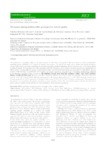Use este identificador para citar ou linkar para este item:
http://www.alice.cnptia.embrapa.br/alice/handle/doc/1058485Registro completo de metadados
| Campo DC | Valor | Idioma |
|---|---|---|
| dc.contributor.author | SOBREIRA, F. M. | pt_BR |
| dc.contributor.author | OLIVEIRA, A. C. B. de | pt_BR |
| dc.contributor.author | PEREIRA, A. A. | pt_BR |
| dc.contributor.author | MARTINS, A. G. | pt_BR |
| dc.contributor.author | SAKIYAMA, N. S. | pt_BR |
| dc.date.accessioned | 2016-12-13T11:11:11Z | pt_BR |
| dc.date.available | 2016-12-13T11:11:11Z | pt_BR |
| dc.date.created | 2016-12-13 | pt_BR |
| dc.date.issued | 2016 | pt_BR |
| dc.identifier.citation | Australian Journal of Crop Science, v. 10, n. 10, p. 1442-1448, out. 2016 | pt_BR |
| dc.identifier.uri | http://www.alice.cnptia.embrapa.br/alice/handle/doc/1058485 | pt_BR |
| dc.description | The production of specialty coffees is the main criterion to add value to the product. However, there is a lack of information regarding genetic variability of C. arabica for quality improvement. The aim of this study was to analyze the genetic divergence among Coffee arabica genotypes regarding the potential cup quality, possible limitations and their potential use in breeding programs to improve quality. We evaluated 101 coffee genotypes from the Germplasm Active Bank of Empresa de Pesquisa Agropecuária de Minas Gerais, covering different groups of genealogical origin. A randomized block design was used with two replications. Sensory analysis of the beverage was performed by two tasters per sample (repetition), using the Cup of Excellence methodology enhanced by the Brazilian Specialty Coffee Association. The attributes assessed were clean cup, sweetness, acidity, body, flavor, aftertaste, balance, overall and final score. K-means and Ward clustering methods were used to study the genotypes divergence. Based on sensory scores, the formed clusters differed with regards to all sensory characteristics (P ≤ 0.01). Three K-means clusters were formed among 40, 45 and 16 genotypes, with final average scores of 80.11, 83.17 and 87.56 points, respectively. Ninety percent of the genotypes evaluated have the genetic potential to produce specialty coffees. The observed divergence indicates the potential of genetic gains for quality and the Híbrido de Timor germplasm can be used for this purpose. | pt_BR |
| dc.language.iso | eng | eng |
| dc.rights | openAccess | eng |
| dc.subject | Híbrido de timor | pt_BR |
| dc.subject | Specialty coffee | pt_BR |
| dc.subject | Bourbon | pt_BR |
| dc.title | Divergence among arabica coffee genotypes for sensory quality. | pt_BR |
| dc.type | Artigo de periódico | pt_BR |
| dc.date.updated | 2016-12-13T11:11:11Z | pt_BR |
| dc.subject.nalthesaurus | Genetic resources | pt_BR |
| riaa.ainfo.id | 1058485 | pt_BR |
| riaa.ainfo.lastupdate | 2016-12-13 | pt_BR |
| dc.contributor.institution | FABRÍCIO MOREIRA SOBREIRA, Instituto Federal de Educação, Ciência e Tecnologia Catarinense; ANTONIO CARLOS BAIAO DE OLIVEIRA, SAPC; ANTONIO ALVES PEREIRA, SAPC; ANDRÉ GUARÇONI MARTINS, INCAPER; NEY SUSSUMU SAKIYAMA, UFV. | pt_BR |
| Aparece nas coleções: | Artigo em periódico indexado (SAPC)  | |
Arquivos associados a este item:
| Arquivo | Descrição | Tamanho | Formato | |
|---|---|---|---|---|
| Divergenceamongarabicacoffee.pdf | 637.39 kB | Adobe PDF |  Visualizar/Abrir |









